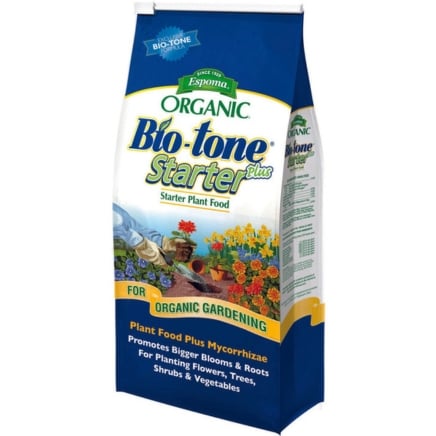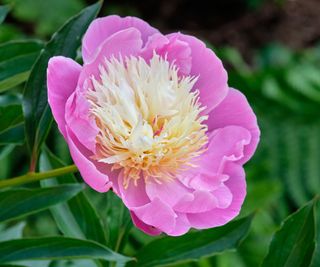Without mycorrhizae, many plants would shrivel, wither, and die. They’re a group of unseen fungi that work alongside other organisms to better soils. When you walk through a forest, there’s a chance you’re stepping on thousands of living mycorrhizal fungi.
But what are they, exactly? Fungi’s most basic structures are tiny little hyphae that sprout from spores. These hyphae form mycelia, which are thin, white filaments. They’re like the roots of fungi, and they spread out in search of nutrients and plant hosts.
Mycorrhizae are a type of mycelia that form partnerships with living shrubs, trees, and perennials. They bond with roots and foster a symbiotic relationship with their hosts. Some plants need them to survive, while others merely benefit from their presence.
Dive into the world of mycorrhizal fungi and see if they’re the right fit for your garden crops and ornamentals.
Bio-tone Organic Plant Food
Espoma Bio-tone Starter Plus Organic Plant Food (4 lbs.)
 Most soils naturally contain mycorrhizae already.
Most soils naturally contain mycorrhizae already.
Mycorrhizal fungi are various species with mycelia filaments that bond with plant roots. Some have specific hosts, like pine trees in North America, while others are more generalist. Most soils naturally contain mycorrhizae already. Compost, mulch, and a diverse range of garden plants encourage a multitude of these fungi to thrive.
Rototilling, synthetic fertilizers, and destructive gardening methods kill the sensitive mycelia below the soil. Gardens with these soils may need additional amendments that are rich with mycorrhizae.
 Some gardeners may not need to amend their beds, while others should.
Some gardeners may not need to amend their beds, while others should.
Whether or not these ancient fungi are good for your garden depends on your landscape’s conditions. Some gardeners may not need to amend their beds, while others should. We’ll learn to encourage mycorrhizal growth over time and how to quickly inoculate soils with mycelia.
Puerto Rican Pines
 Mycorrhizae were the motivating factor behind the pines’ success.
Mycorrhizae were the motivating factor behind the pines’ success.
Before we dive into care, there’s a story to discuss that perfectly illustrates how crucial mycorrhizal fungi are for plant roots. In the 1930s, the USDA Forest Service brought nonnative pine seeds from South Carolina to plant in Puerto Rico. They were attempting to grow valuable timber in a new location.
Years of trying to grow these pine trees proved futile—the seedlings would sprout, wither, and die. It wasn’t until 1955, when B.J. Huckenpahler brought native soil from South Carolina to Puerto Rico and planted seeds, that the Forest Service had a breakthrough. The seedlings in the native soil thrived and grew to five feet tall a year later!
After the experiment, extra research proved that mycorrhizae were the motivating factor behind the pines’ success. The seedlings that shriveled and died missed their fungal counterparts and couldn’t survive in their new location without them.
Encourage Natural Mycorrhizae
 It protects bare soils, keeping sensitive mycelia strands safe from trampling and tampering.
It protects bare soils, keeping sensitive mycelia strands safe from trampling and tampering.
These special fungi naturally colonize rich soils with a diverse range of species. When you grow a mix of native plants in your yard, you invite native mycorrhizae into the space. Our favorite crops and ornamental species also work well with them, and they add to the diversity of your soil.
Mulch is another great way to encourage mycorrhizal fungi into the dirt. It protects bare soils, keeping sensitive mycelia strands safe from trampling and tampering. It also injects nutrients slowly as it decomposes, creating a rich habitat for fungi.
The last, but certainly not least, effective way to encourage natural mycorrhizae populations is to add compost to your garden beds. Compost lends structure, nutrients, and other beneficial critters to existing soils. It might also contain spores that can grow into new hyphae and mycelia.
Add Organic Fertilizer With Mycorrhizae
 Roll their roots in the powder or place the powder in the transplanting holes.
Roll their roots in the powder or place the powder in the transplanting holes.
Even if your soils already have mycorrhizae, they won’t hurt from additional applications. Unlike fertilizer, too much of these fungi won’t damage soil structure or life. As more and more research unveils the importance of these organisms, more companies are making products with them in it.
Consider using an organic fertilizer with these fungi already in them. With these fertilizers, you’ll inoculate your garden with mycorrhizae every time you add them.
Other products exist without nutrients and are simply powders or propagules with mycorrhizae inside. These pure fungal mixes are excellent for transplanting seedlings. Roll their roots in the powder, and place the powder in the transplanting holes. It won’t hurt them—it’ll boost their growth, making them more resilient to drought, pests, and diseases.
Rototilling Kills Mycorrhizae
 Any disturbing action that breaks up soil particles may fracture and kill them before they form extensive populations.
Any disturbing action that breaks up soil particles may fracture and kill them before they form extensive populations.
Mycelia strands are extremely sensitive! Any disturbing action that breaks up soil particles may fracture and kill them before they form extensive populations. If soils received tilling in the past, you’ll want to add lots of mycorrhizal amendments, compost, and mulch.
Avoid tilling unless it’s necessary. New no-till gardening methods prove that bountiful harvests aren’t truly dependent on tilling and fertilizers, but rather on soil health. Build up your soil with beneficial microbes by adding amendments on top, and avoiding digging into sensitive fungal strands.
Tilling may be necessary for breaking up a hardpan or for starting a new vegetable garden. When done once, these actions aren’t too harmful. But excessive tilling is especially damaging—avoid it if you want to foster mycorrhizal strands.
Aside from tilling, chemical fertilizers, pesticides, and herbicides may also harm sensitive mycelia. Avoid synthetic chemicals, as they kill at will and sometimes damage sensitive fungi below the soil. Only use organic fertilizers and pesticides when necessary.
Some Plants Don’t Need Them
 Any plant in the cabbage family (Brassicaceae) is non-mycorrhizal.
Any plant in the cabbage family (Brassicaceae) is non-mycorrhizal.
There are times when you may not need these fungi. Any plant in the cabbage family Brassicaceae doesn’t form relationships with them and won’t benefit from their addition. Some of these common unaffected plants are:
- Arugula
- Broccoli
- Cabbage
- Cauliflower
- Candytuft
- Radish
- Turnip
The other family that has a different relationship with mycorrhizae is the Ericaceae family. This includes many different ornamental and edible species we love to grow in our gardens. Blueberries, cranberries, and lingonberries bond with a specific set of fungi. Common ornamental species that don’t rely on the more general types you’d find bonding with most plants are rhododendrons, mountain laurels, heaths, and heathers. You can find the specific Ericoid mycorrhizae in stores if you’d like to include them.
Just because these species don’t need general mycorrhizae doesn’t mean you shouldn’t add plenty of compost and mulch to your garden beds annually. They’ll benefit from the presence of bacteria, worms, and other critters that inhabit organic amendments. Compost also adds structure and nutrients to soils, helping species in the Brassicaceae and Ericaceae families.
Other Beneficial Soil Microbes
 They cycle nutrients, better soil structure, and suppress diseases.
They cycle nutrients, better soil structure, and suppress diseases.
Bacteria and archaea are the other two tiny organisms that often accompany fungi in healthy soils. Bacteria are the most abundant, although they aren’t the oldest. The archaea are the oldest organisms, having been around for about four billion years.
Bacteria have many jobs when they inhabit soils—they cycle nutrients, better soil structure, and suppress nasty diseases. Adding compost ensures a steady supply of these microbes. Their abundance means they’ll find their way into your soil one way or another! Archaea are different; they eat and break down carbon and nitrogen, among other nutrients, for roots to access.
Larger creatures also work to better soils, although they aren’t technically microbes. Algae, protozoa, nematodes, and worms all eat large particles and turn them into smaller ones for plants. Cultivate healthy soils, and you’ll create living populations of each beneficial critter.




